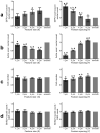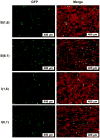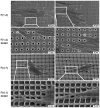High-throughput screening of microscale pitted substrate topographies for enhanced nonviral transfection efficiency in primary human fibroblasts
- PMID: 21334062
- PMCID: PMC3052739
- DOI: 10.1016/j.biomaterials.2011.01.040
High-throughput screening of microscale pitted substrate topographies for enhanced nonviral transfection efficiency in primary human fibroblasts
Abstract
Optimization of nonviral gene delivery typically focuses on the design of particulate carriers that are endowed with desirable membrane targeting, internalization, and endosomal escape properties. Topographical control of cell transfectability, however, remains a largely unexplored parameter. Emerging literature has highlighted the influence of cell-topography interactions on modulation of many cell phenotypes, including protein expression and cytoskeletal behaviors implicated in endocytosis. Using high-throughput screening of primary human dermal fibroblasts cultured on a combinatorial library of microscale topographies, we have demonstrated an improvement in nonviral transfection efficiency for cells cultured on dense micropit patterns compared to smooth substrates, as verified with flow cytometry. A 25% increase in GFP(+) cells was observed independent of proliferation rate, accompanied by SEM and confocal microscopy characterization to help explain the phenomenon qualitatively. This finding encourages researchers to investigate substrate topography as a new design consideration for the optimization of nonviral transfection systems.
Copyright © 2011 Elsevier Ltd. All rights reserved.
Figures






Similar articles
-
The effect of micro and nanotopography on endocytosis in drug and gene delivery systems.Biomaterials. 2011 Dec;32(36):9866-75. doi: 10.1016/j.biomaterials.2011.08.088. Epub 2011 Sep 15. Biomaterials. 2011. PMID: 21924770
-
Optimizing nonviral-mediated transfection of human intervertebral disc chondrocytes.Spine J. 2008 Sep-Oct;8(5):796-803. doi: 10.1016/j.spinee.2007.05.010. Epub 2007 Jul 19. Spine J. 2008. PMID: 18023624
-
Topography-Mediated Enhancement of Nonviral Gene Delivery in Stem Cells.Pharmaceutics. 2022 May 20;14(5):1096. doi: 10.3390/pharmaceutics14051096. Pharmaceutics. 2022. PMID: 35631682 Free PMC article.
-
Polymer-coated viral vectors: hybrid nanosystems for gene therapy.J Gene Med. 2018 Apr;20(4):e3011. doi: 10.1002/jgm.3011. Epub 2018 Mar 25. J Gene Med. 2018. PMID: 29423922 Review.
-
Nanoparticles as nonviral gene delivery vectors.IEEE Trans Nanobioscience. 2007 Dec;6(4):319-30. doi: 10.1109/tnb.2007.908996. IEEE Trans Nanobioscience. 2007. PMID: 18217625 Review.
Cited by
-
Inorganic coatings for optimized non-viral transfection of stem cells.Sci Rep. 2013;3:1567. doi: 10.1038/srep01567. Sci Rep. 2013. PMID: 23535735 Free PMC article.
-
3-D Scaffold Platform for Optimized Non-viral Transfection of Multipotent Stem Cells.J Mater Chem B. 2014 Dec 14;2(46):8186-8193. doi: 10.1039/C4TB00957F. J Mater Chem B. 2014. PMID: 25541592 Free PMC article.
-
Designing electrospun fiber platforms for efficient delivery of genetic material and genome editing tools.Adv Drug Deliv Rev. 2022 Apr;183:114161. doi: 10.1016/j.addr.2022.114161. Epub 2022 Feb 17. Adv Drug Deliv Rev. 2022. PMID: 35183657 Free PMC article. Review.
-
Physical non-viral gene delivery methods for tissue engineering.Ann Biomed Eng. 2013 Mar;41(3):446-68. doi: 10.1007/s10439-012-0678-1. Epub 2012 Oct 26. Ann Biomed Eng. 2013. PMID: 23099792 Free PMC article. Review.
-
Chitosan/siCkip-1 biofunctionalized titanium implant for improved osseointegration in the osteoporotic condition.Sci Rep. 2015 Jun 4;5:10860. doi: 10.1038/srep10860. Sci Rep. 2015. PMID: 26040545 Free PMC article.
References
-
- Kong HJ, Liu J, Riddle K, Matsumoto T, Leach K, Mooney DJ. Non-viral gene delivery regulated by stiffness of cell adhesion substrates. Nat Mater. 2005;4(6):460–4. - PubMed
-
- Yoshikawa T, Uchimura E, Kishi M, Funeriu DP, Miyake M, Miyake J. Transfection microarray of human mesenchymal stem cells and on-chip siRNA gene knockdown. J Control Release. 2004;96(2):227–32. - PubMed
-
- Uchimura E, Yamada S, Nomura T, Matsumoto K, Fujita S, Miyake M, et al. Reverse transfection using antibodies against a cell surface antigen in mammalian adherent cell lines. J Biosci Bioeng. 2007;104(2):152–5. - PubMed
Publication types
MeSH terms
Grants and funding
LinkOut - more resources
Full Text Sources
Other Literature Sources
Research Materials

